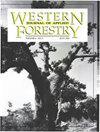A Retrospective Assessment of Partial Cutting to Reduce Spruce Beetle-Caused Mortality in the Southern Rocky Mountains
引用次数: 25
Abstract
Tree susceptibility to bark beetle-caused mortality has been linked to stand characteristics such as basal area (BA) and average tree size, factors that can be manipulated through partial cutting. There is no experimental evidence, however, demonstrating the efficacy of partial cutting in spruce type. Such experiments are very difficult to complete because of the inability to manipulate bark beetle populations needed to challenge treated stands. To circumvent this difficulty, we identified spruce stands that were partially cut (for nonexperimental reasons) in advance of beetle activity and compared beetle-caused mortality to that in nearby spruce stands that were not treated. Treated stands had fewer infested stems and less infested BA than untreated stands, as well as smaller proportions of infested stems and BA. Untreated stands, however, had more residual spruce stems and BA than treated stands. Most of this difference was among stems 3-11 in. dbh with little difference in survivorship among larger stems. Spruce regeneration was not significantly different among treated and untreated stands. Spruce stand density index, spruce BA, and the number of spruce stems 11 in. dbh were the stand variables most strongly correlated with host mortality measurements. Insect population pressure appears to influence the degree of protection to residual spruce following partial cutting.部分采伐减少南落基山脉云杉甲虫死亡率的回顾性评估
树木对树皮甲虫引起的死亡的敏感性与林分特征有关,如基底面积(BA)和平均树高,这些因素可以通过部分砍伐来操纵。然而,没有实验证据证明部分采伐对云杉类型的有效性。这样的实验很难完成,因为无法控制树皮甲虫的数量来挑战被处理过的林分。为了克服这一困难,我们确定了在甲虫活动之前被部分砍伐(非实验原因)的云杉林,并将甲虫引起的死亡率与附近未处理的云杉林进行了比较。与未处理林分相比,处理林分的茎部侵染较少,BA侵染较少,茎部侵染比例和BA侵染比例较小。然而,未经处理的林分比处理林分有更多的残余云杉茎和BA。这种差异主要发生在3-11英寸的茎上。大茎间胸径差异不大。云杉再生在处理林分和未处理林分之间无显著差异。云杉林分密度指数、云杉BA和云杉茎数。胸径是与寄主死亡率测量结果相关性最强的林分变量。昆虫种群压力似乎影响了部分采伐后对残余云杉的保护程度。
本文章由计算机程序翻译,如有差异,请以英文原文为准。
求助全文
约1分钟内获得全文
求助全文

 求助内容:
求助内容: 应助结果提醒方式:
应助结果提醒方式:


